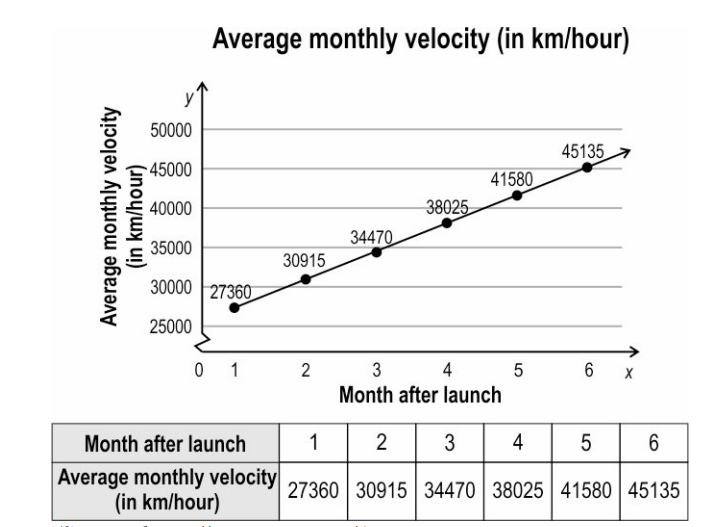Answer the questions based on the given information.
In space exploration missions, ion propulsion engine is an efficient way of travelling. The first such engine was used in Deep Space 1 spacecraft. It produced a constant acceleration. Given below are approximate velocities of the engine.
The initial average velocity of the engine in its first month was 27360 km/hour. When the spacecrafts passed the asteroid, Braille, it reached an average velocity of 55800 km/hour. Based on the first 6 months of Deep Space 1's monthly average velocity, the following table was created.

i) Does the average monthly velocity (in km/hour) form an arithmetic progression? Justify your answer.
ii) The distance travelled by the spacecraft in the first 10 months (or 7300 hours) can be expressed as 7300p km where p is the sum of average monthly velocity for the first 10 months.
Find p. Show your work.
iii) The spacecraft passed the comet, Borelly, 15 months after it passed Braille.
Find the average monthly velocity of the spacecraft when it passed Borelly. Show your work.
OR
After how many months did the spacecraft pass Braille? Show your work.
Step by step video & image solution for Answer the questions based on the given information. In space exploration missions, ion propulsion engine is an efficient way of travelling. The first such engine was used in Deep Space 1 spacecraft. It produced a constant acceleration. Given below are approximate velocities of the engine. The initial average velocity of the engine in its first month was 27360 km/hour. When the spacecrafts passed the asteroid, Braille, it reached an average velocity of 55800 km/hour. Based on the first 6 months of Deep Space 1's monthly average velocity, the following table was created. i) Does the average monthly velocity (in km/hour) form an arithmetic progression? Justify your answer. ii) The distance travelled by the spacecraft in the first 10 months (or 7300 hours) can be expressed as 7300p km where p is the sum of average monthly velocity for the first 10 months. Find p. Show your work. iii) The spacecraft passed the comet, Borelly, 15 months after it passed Braille. Find the average monthly velocity of the spacecraft when it passed Borelly. Show your work. OR After how many months did the spacecraft pass Braille? Show your work. by Maths experts to help you in doubts & scoring excellent marks in Class 10 exams.
Updated on:21/07/2023Topper's Solved these Questions
Similar Questions
Knowledge Check
The first gasoline-run car engine was developed by:
AHanry FordBCarl BenzCHugh ChalmersDHorace Elgin DodgeEfficiency of heat engine is defined as the
Aproduct of the work done by the heat engine and amount of heat supplied to it.Bratio of the amount of heat supplied to it and work done by the heat engine.Cratio of the work done by the heat engine and amount of heat supplied to it.Dratio of amount of heat supplied to it and amount of heat dissipatedEfficiency of the engine in the above questions is
A30%B10%C20%D80%
